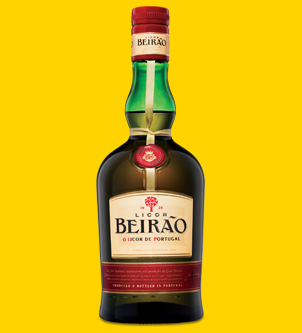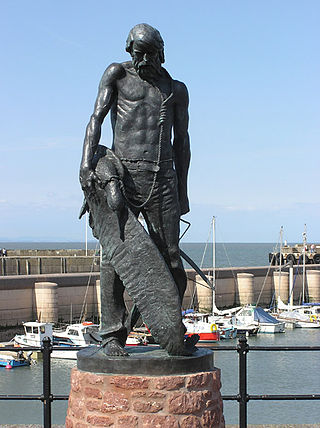Related Research Articles

A cocktail is an alcoholic mixed drink. Most commonly, a cocktail is a combination of one or more spirits mixed with other ingredients, such as juices, flavored syrups, tonic water, shrubs, and bitters. Cocktails vary widely across regions of the world, and many websites publish both original recipes and their own interpretations of older and more famous cocktails.

A liqueur is an alcoholic drink composed of spirits and additional flavorings such as sugar, fruits, herbs, and spices. Often served with or after dessert, they are typically heavily sweetened and un-aged beyond a resting period during production, when necessary, for their flavors to mingle.

The old fashioned is a cocktail made by muddling sugar with bitters and water, adding whiskey or sometimes brandy, and garnishing with an orange slice or zest and a cocktail cherry. It is traditionally served with ice in an old fashioned glass.

The Mai Tai is a cocktail made of rum, Curaçao liqueur, orgeat syrup, and lime juice. It is one of the characteristic cocktails in Tiki culture.

Allspice, also known as Jamaica pepper, myrtle pepper, pimenta, or pimento, is the dried unripe berry of Pimenta dioica, a midcanopy tree native to the Greater Antilles, southern Mexico, and Central America, now cultivated in many warm parts of the world. The name allspice was coined as early as 1621 by the English, who valued it as a spice that combined the flavours of cinnamon, nutmeg, and clove.
Jamaican cuisine includes a mixture of cooking techniques, flavours and spices influenced by Amerindian, West African, Irish, English, French, Portuguese, Spanish, Indian, Chinese and Middle Eastern people who have inhabited the island. It is also influenced by the crops introduced into the island from tropical Southeast Asia, many of which are now grown locally. A wide variety of seafood, tropical fruits and meats are available.

Falernum is either an 11% ABV syrup liqueur or a nonalcoholic syrup from the Caribbean. It is best known for its use in tropical drinks. It contains flavors of ginger, lime, and almond, and frequently cloves or allspice. It may be thought of as a spicier version of orgeat syrup.

Advocaat or advocatenborrel is a traditional Dutch alcoholic beverage made from eggs, sugar, and brandy. The rich and creamy drink has a smooth, custard-like consistency. The typical alcohol content is generally between 14% and 20% ABV. Its contents may be a blend of egg yolks, aromatic spirits, sugar or honey, brandy, vanilla, and sometimes cream. Notable makers of advocaat include Warninks, Bols, Darna Ovo Liker, DeKuyper, and Verpoorten.
Curaçao is a liqueur flavored with the dried peel of the bitter orange laraha, a citrus fruit grown on the Caribbean island of Curaçao.

Tia Maria is a dark coffee liqueur made in Italy using Jamaican coffee beans. The main ingredients are coffee beans, Jamaican rum, vanilla, and sugar, blended to an alcoholic content of 20%.

Vana Tallinn is an Estonian brand of liqueur manufactured continuously by Liviko since 1960. The recipe contains Jamaican rum and a variety of herbs and spices.

A liqueur coffee is a caffeinated alcoholic drink that consists of a shot of liqueur, mixed with coffee. It is typically served in a liqueur glass, often accompanied with cream and sugar. Coffee liqueur beverages are served in different fashions and can be found throughout many countries. One of the most popular liqueur coffee beverage is commonly known as Irish coffee. Liqueur coffee beverages are largely classified as cocktails as well as digestifs which are aimed at aiding the digestive process typically after a meal.

The Pimm's cup is a cocktail that is popular in England, in the United Kingdom. It is one of numerous fruit cups, a type of cocktail with gin, a soft drink, and fruit. Its primary spirit is Pimm's No. 1 Cup, a gin-based beverage flavored with fruits and spices invented around 1823 as a health drink.

Rum is a liquor made by fermenting and then distilling sugarcane molasses or sugarcane juice. The distillate, a clear liquid, is often aged in barrels of oak. While associated with the Caribbean due to its Barbadian origin, rum is nowadays produced in nearly every major sugar-producing region of the world, such as the Philippines, where Tanduay Distillers, the largest producer of rum worldwide, has its headquarters.

A rum swizzle is a rum-based cocktail often called "Bermuda's national drink". The Royal Gazette has referred to it as "the legendary Sam swizzle...perfect for sharing and irresistible to locals and tourists alike". In addition to providing the "swizzle" portion of the 1933 swizzle stick product name, it has been said that this potent cocktail is "as much a part of Bermuda Island culture and cuisine as is the Bermuda onion, the vibrant hibiscus, or the graceful Bermuda Longtail."

Toussaint Coffee Liqueur is a coffee-flavoured liqueur prepared with a rum base that originated in Haiti, commemorating the revolutionary hero Toussaint Louverture. Its alcohol by volume content is 30%.

The Ancient Mariner is a tiki drink created by Jeff "Beachbum" Berry and Annene Kaye. It first appeared in their 1998 drink guide Beachbum Berry's Grog Log and is named after Coleridge's 1798 The Rime of the Ancient Mariner because in Berry's words "by the time we finished with it, that's how old we felt."
References
- ↑ Cate, Martin; Cate, Rebecca (7 June 2016). Smuggler's Cove: Exotic Cocktails, Rum, and the Cult of Tiki. ISBN 9781607747338.
- ↑ Rothbaum, Noah (14 October 2021). The Oxford Companion to Spirits and Cocktails. ISBN 978-0-19-067040-5.
- ↑ "Descriptive Catalogue of Articles Exhibited by the Royal Society of Arts, Jamaica ... At the International Exhibition 1862". 1862.